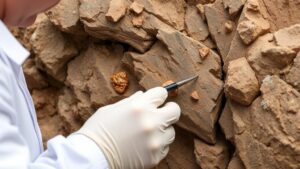How to Research Mining Claim Serial Numbers in Government Databases
Introduction
Mining claim serial numbers are crucial identifiers in the mining industry, serving as a reference for tracking claims in government databases. Understanding how to research these numbers is imperative for prospectors, landowners, and companies engaged in mining operations. Historically, mining claims were simply marked by physical stakes in the ground. But, with advancements in technology and regulatory frameworks, record-keeping has evolved into complex governmental databases that require systematic research to navigate.
The importance of accurately researching mining claim serial numbers cannot be overstated. With over 1.31 million active mining claims in the United States alone, accessed through the Bureau of Land Management (BLM) and various state agencies, due diligence in research helps in avoiding overlapping claims, understanding ownership history, and navigating legal compliance during exploration or extraction.
Foundational Concepts and Equipment
Before embarking on research, its essential to grasp foundational concepts surrounding mining claims and the tools used for effective investigation. Key terminology includes:
- Mining Claim: A designated piece of land where individuals can extract minerals.
- Serial Number: A unique identifier assigned to each mining claim, crucial for tracking in government databases.
- BLM Database: The Bureau of Land Management database that includes extensive information about mining claims across the United States.
To research mining claim serial numbers effectively, the following tools are necessary:
- Computer or Mobile Device: Essential for online database searches.
- GPS Device: Useful for confirming physical locations of claims.
- Mapping Software: Programs like GIS that help visualize claim boundaries.
Step-by-Step Methodology
Researching mining claim serial numbers follows a structured methodology. Below is a step-by-step guide:
- Identify your claim: Determine the mining claims name or associated serial number.
- Access the BLM Database: Visit the BLM’s official website or the state-specific mining claims database.
- Search for the serial number: Enter the serial number into the search tool to retrieve information regarding the claim.
- Review Claim Information: Analyze the owner, location, and status of the claim, including any historical data.
- Cross-Reference with State Databases: Check state-level databases to confirm details and avoid discrepancies.
This methodology not only benefits prospective miners but also assists legal professionals and land surveyors in understanding property rights.
Advanced Techniques
For those looking to deepen their research skills, advanced techniques can offer more precise data analysis and efficiency. Key methods include:
- Data Mining Tools: Use specialized software that extracts and analyzes large data sets from government records, allowing for quicker assessments of multiple claims.
- GIS Mapping: Employ Geographic Information Systems to assess claim locations visually and understand geological contexts, which can enhance strategic planning.
- Record Request Forms: Submit formal requests for additional public records that may not be available online, facilitating a comprehensive understanding of all ownerships and previous claim activities.
Legal, Ethical, and Safety Frameworks
Engaging in mining activities necessitates adherence to legal and ethical considerations. Important aspects include:
- Permitting Requirements: Ensure you understand local, state, and federal regulations governing mining claims.
- Environmental Compliance: Be aware of laws that protect natural resources and ecosystems, which can impact claim exploitation.
- Land Rights and Ownership: Conduct thorough research to avoid infringing on private property or existing claims, which could lead to lawsuits or fines.
Familiarity with the legal framework enhances not only compliance but also the long-term sustainability of mining practices.
Practical Field Guidance and Resources
When scouting potential mining claim sites, certain criteria can help identify optimal locations:
- Geological Surveys: Review geological maps and studies to find areas rich in the desired minerals.
- Accessibility: Ensure the site is approachable for both transportation and extraction activities.
- Proximity to Infrastructure: Look for nearby roads, utilities, and resources that support mining operations.
Also, utilize resources such as local prospecting clubs, state mining agencies, and online forums for community insights and ongoing developments in mining regulations and techniques.
Following these guidelines not only enhances your research capabilities but also positions you favorably in the mining industry, whether as a novice prospector or an experienced company.



